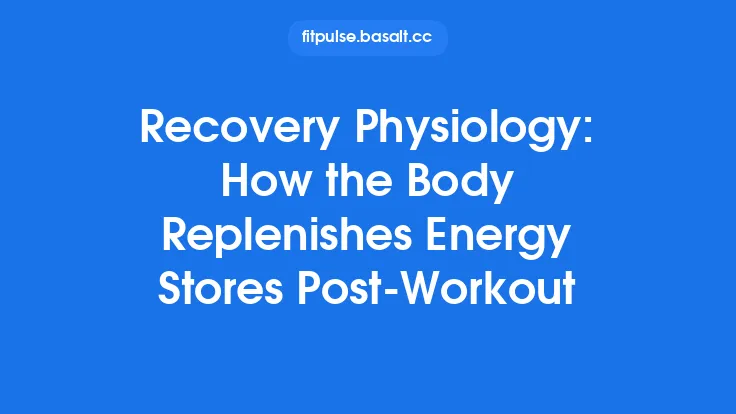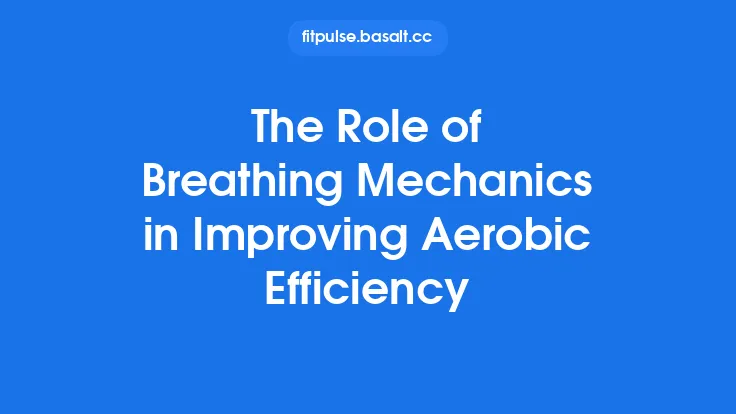Aerobic exercise is a powerful stimulus that reshapes virtually every organ system involved in delivering oxygen to working muscles and converting that oxygen into usable energy. Understanding how the body generates endurance requires a look at the cascade of physiological events that begin the moment you start moving and continue long after the workout ends. Below is a comprehensive exploration of the key mechanisms that underlie aerobic performance, from the heart’s pump to the microscopic power plants within each muscle fiber.
The Cardiovascular Engine: How the Heart and Blood Vessels Adapt
Stroke Volume and Cardiac Output
During aerobic activity, the heart must pump a larger volume of blood to meet the heightened demand for oxygen. Stroke volume—the amount of blood ejected with each heartbeat—increases through two primary mechanisms:
- Enhanced Venous Return – Repetitive muscle contractions act as a peripheral “muscle pump,” pushing blood back toward the heart and stretching the ventricular walls (the Frank‑Starling mechanism). This stretch leads to a more forceful contraction.
- Myocardial Hypertrophy – Endurance training induces eccentric hypertrophy, where the left ventricle walls thicken modestly while the chamber enlarges. This structural change allows the heart to accommodate a greater end‑diastolic volume without a proportional rise in wall stress, thereby boosting stroke volume.
Because cardiac output (CO) equals heart rate (HR) × stroke volume (SV), a higher SV means the heart can maintain a given CO at a lower HR, which is why trained athletes often have lower resting and submaximal exercise heart rates.
Blood Volume Expansion
Regular aerobic training stimulates plasma volume expansion (up to 20 % in well‑conditioned individuals) and a modest increase in red blood cell mass. The net effect is a higher total blood volume, which improves stroke volume and enhances the oxygen‑carrying capacity of the circulatory system. This adaptation also aids thermoregulation by providing a larger reservoir for heat dissipation.
Capillary Proliferation (Angiogenesis)
Endurance exercise triggers the release of vascular endothelial growth factor (VEGF) and other angiogenic signals from active muscle fibers. Over weeks to months, new capillaries sprout from existing vessels, increasing the capillary-to-fiber ratio. This dense capillary network shortens the diffusion distance for oxygen and metabolites, facilitating more efficient exchange between blood and muscle.
Respiratory Adjustments: Maximizing Oxygen Uptake
Ventilatory Efficiency
While the primary focus of this article is not breathing mechanics per se, it is worth noting that aerobic training improves the coordination between ventilation (breathing) and perfusion (blood flow) in the lungs. The alveolar–arterial oxygen gradient narrows, allowing a greater proportion of inhaled oxygen to enter the bloodstream with each breath.
Increased Diffusing Capacity
Repeated exposure to higher ventilation rates stimulates remodeling of the alveolar–capillary membrane, increasing its surface area and thinning the diffusion barrier. This structural change raises the diffusing capacity for oxygen (DL_O2), which becomes especially important during high‑intensity aerobic bouts when the time for gas exchange is limited.
Muscular Metabolism: From Glycogen to Fatty Acids
Fuel Selection Shifts
At low to moderate intensities, skeletal muscle relies heavily on oxidative phosphorylation of fatty acids. As intensity rises, carbohydrate oxidation (glycogen breakdown) contributes a larger share of ATP production. Endurance training expands the muscle’s ability to oxidize both substrates:
- Enhanced Lipid Mobilization – Training upregulates hormone‑sensitive lipase activity in adipose tissue and increases the expression of fatty acid transport proteins (e.g., FAT/CD36) on muscle membranes, facilitating greater fatty acid uptake.
- Improved Glycogen Sparing – With a more robust oxidative capacity, muscles can preserve glycogen stores for higher‑intensity efforts, delaying the onset of fatigue.
Mitochondrial Biogenesis
The hallmark of aerobic adaptation is an increase in mitochondrial content. The transcriptional co‑activator peroxisome proliferator‑activated receptor‑γ coactivator‑1α (PGC‑1α) is activated by calcium flux, AMP‑activated protein kinase (AMPK), and reactive oxygen species generated during exercise. PGC‑1α drives the expression of nuclear‑encoded mitochondrial genes and coordinates the replication of mitochondrial DNA, resulting in:
- Higher Maximal Oxidative Enzyme Activity – Enzymes such as citrate synthase, β‑hydroxyacyl‑CoA dehydrogenase, and cytochrome c oxidase become more abundant, accelerating the rate at which substrates are processed through the tricarboxylic acid (TCA) cycle and electron transport chain.
- Increased Mitochondrial Density – More mitochondria per unit of muscle fiber translate directly into a greater capacity for aerobic ATP production.
Oxidative Phosphorylation Efficiency
Training improves the coupling efficiency of oxidative phosphorylation, meaning a higher proportion of the oxygen consumed is converted into ATP rather than dissipated as heat. This efficiency is reflected in a lower oxygen cost for a given workload, a key determinant of endurance performance.
Hemoglobin and Oxygen Transport
Erythropoietic Response
Endurance training can modestly stimulate erythropoietin (EPO) production, especially when training at altitude or in hypoxic conditions. The resulting increase in red blood cell count raises hemoglobin concentration, enhancing the blood’s oxygen‑binding capacity. While the magnitude of this adaptation varies among individuals, it contributes to a higher arterial oxygen content (CaO₂) and thus a greater oxygen delivery potential.
2,3‑Bisphosphoglycerate (2,3‑BPG) Modulation
Chronic aerobic training can elevate intracellular 2,3‑BPG levels in red blood cells, shifting the hemoglobin–oxygen dissociation curve to the right. This shift facilitates oxygen release at the tissue level, ensuring that active muscles receive oxygen more readily.
Hormonal and Autonomic Regulation
Catecholamine Dynamics
During prolonged aerobic exercise, circulating epinephrine and norepinephrine rise, stimulating glycogenolysis, lipolysis, and cardiac output. With training, the sensitivity of adrenergic receptors improves, allowing the same hormonal signal to elicit a stronger metabolic response while overall catecholamine concentrations at a given intensity may be lower—a sign of improved efficiency.
Insulin Sensitivity
Regular aerobic activity enhances skeletal muscle insulin sensitivity by increasing GLUT4 transporter expression and translocation. Better glucose uptake supports glycogen replenishment post‑exercise and provides an additional substrate for oxidative metabolism during subsequent sessions.
Autonomic Balance – Endurance training augments parasympathetic (vagal) tone at rest, reflected in higher heart‑rate variability (HRV). This shift contributes to lower resting heart rates and a more rapid return to baseline after exercise, indirectly supporting sustained aerobic performance.
Cellular Signaling Pathways that Drive Adaptation
| Pathway | Primary Trigger | Main Effect on Endurance |
|---|---|---|
| AMPK | ↑ AMP/ATP ratio during energy stress | Activates PGC‑1α, promotes glucose uptake, stimulates fatty‑acid oxidation |
| Ca²⁺/Calmodulin‑dependent protein kinase (CaMK) | Repetitive calcium transients from muscle contraction | Upregulates mitochondrial biogenesis and oxidative enzyme expression |
| p38 MAPK | Mechanical stress and oxidative signals | Enhances transcription of genes involved in mitochondrial function |
| Sirtuins (SIRT1/3) | NAD⁺ availability, metabolic stress | Deacetylates PGC‑1α, improves mitochondrial efficiency and antioxidant defenses |
These pathways converge on a common goal: to expand the muscle’s oxidative infrastructure and improve the efficiency of oxygen utilization.
Integration of Systems During Prolonged Exercise
When you embark on a steady‑state run or a long bike ride, the body operates as a tightly coordinated network:
- Cardiac Output rises to deliver more oxygenated blood.
- Blood is redistributed away from non‑essential organs toward active muscles via vasodilation mediated by nitric oxide and metabolic by‑products.
- Capillary exchange delivers oxygen and removes carbon dioxide and lactate.
- Mitochondria within muscle fibers convert the delivered oxygen into ATP, primarily through the oxidation of fatty acids at lower intensities and a mix of carbohydrates and fats as intensity climbs.
- Hormonal signals fine‑tune substrate availability, ensuring a continuous supply of fuel.
- Neural feedback adjusts ventilation and heart rate to match metabolic demands, maintaining homeostasis.
The efficiency of each link in this chain determines how long you can sustain a given pace before fatigue sets in. Training systematically strengthens each component, resulting in a higher maximal oxygen uptake (VO₂max), a raised lactate threshold, and a lower oxygen cost of exercise—all hallmarks of superior aerobic endurance.
Summary of Key Physiological Adaptations
- Cardiac: Larger stroke volume, expanded blood volume, lower resting and submaximal heart rates.
- Vascular: Increased capillary density, improved endothelial function, enhanced oxygen diffusion.
- Respiratory: Greater alveolar–capillary surface area, higher diffusing capacity.
- Hematologic: Slightly higher hemoglobin concentration, elevated 2,3‑BPG for better tissue oxygen release.
- Muscular: Elevated mitochondrial number and enzyme activity, improved fatty‑acid oxidation, glycogen sparing.
- Metabolic: More efficient oxidative phosphorylation, lower oxygen cost per unit of work.
- Hormonal/Autonomic: Enhanced catecholamine sensitivity, improved insulin action, stronger parasympathetic tone.
- Molecular: Upregulated PGC‑1α, AMPK, CaMK, and related signaling pathways driving biogenesis and metabolic remodeling.
Collectively, these adaptations transform the body from a system that can only meet short bursts of demand into one capable of sustaining prolonged, high‑intensity effort with relative ease. Understanding the underlying physiology not only satisfies scientific curiosity but also provides a solid foundation for designing training programs that target the most impactful mechanisms of endurance development.





